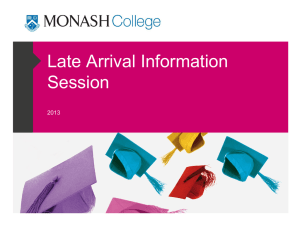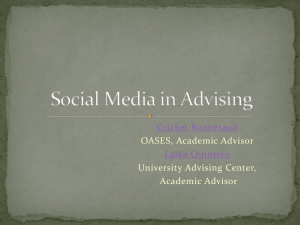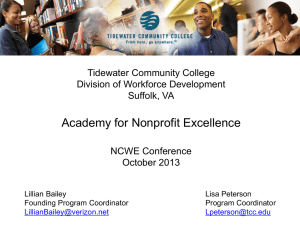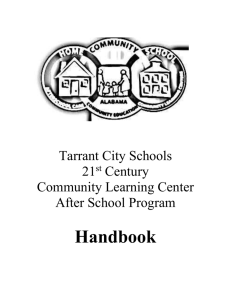Tarrant County College Board Orientation
advertisement
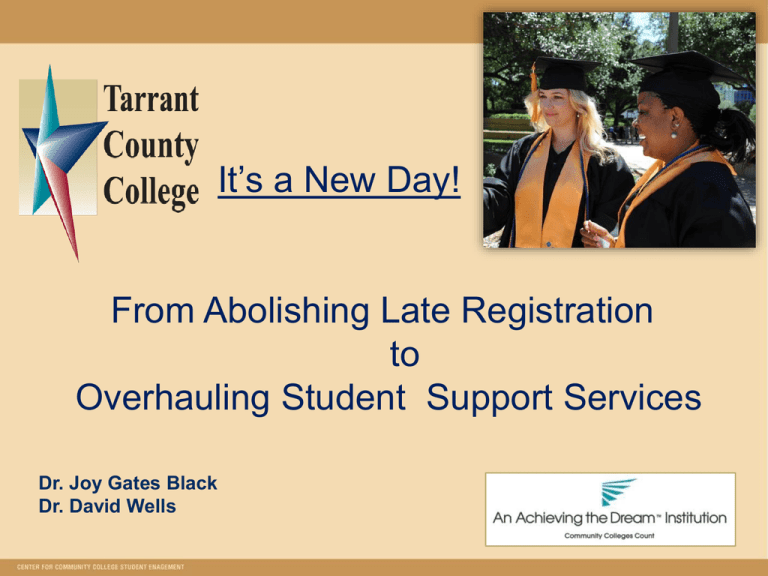
It’s a New Day! From Abolishing Late Registration to Overhauling Student Support Services Dr. Joy Gates Black Dr. David Wells Tarrant County College District • Established in 1965 • 7th Largest College or University in Texas • 1 College, 5 Campuses + Health Professions Campus + Multiple Community Ctrs • 5 Campus Presidents • 3,000 Employees Including Adjuncts • 7 Member Board of Trustees (Single Member Districts) • Service Area: Tarrant County, Texas – 900 Square Miles 1.8 M Population The Way We Were • • • • • • • • • • • Silos, Silos, Silos Allowed students to do optional Enrollment driven Primary use of data was for reporting to regulatory agencies – (Institutional Research office was staffed accordingly) Often employees did not understand the data they were getting Most advising was done by counselors No student success/orientation course Few decisions made on the basis of disaggregated data Administrators concentrated on their silo Minimal professional development and faculty renewal The Institution suffered from a lack of focus and a singular vision Creating a Culture of Inquiry Evidence and Accountability “The Rationale for Change” Using Data to Inform Decision-Making TCC Students: Developmental Education (Ranking Based on Big Ten Community Colleges) Percentage of Developmental Students Who Met a TSI Obligation within Two Years Subject 2009 2010 Reading 9th 8th Writing 8th 8th Math 9th 9th Texas Legislative Budget Board Report on Performance Measures What We Learned From Our Students 2009 TCC - SENSE • Only 13% of students reported that someone was assigned to them in case they needed information or assistance Fall 2009 – Fall 2010 • First Time in College (FTIC) Student Retention = 57% 2010 TCC - CCSSE • Only 23% of students indicated that they used peer or other tutoring sometimes or often • Only 43% of students indicated that they used skill labs (math, writing, etc.) sometimes or often • Only 49% of students indicated that they used academic advising/planning services sometimes or often What We Learned From Our Students 2011 TCC CCSSE Only 25% of students indicated that they had completed a college orientation program 34% of the students surveyed indicated that they work more than 30 hours per week What We Learned From Our Students TCC 2011 CCSSE Most Important Support Services Academic Advising Computer Labs Career Counseling Financial Aid Advising Skill Labs (writing, math, etc.) Peer or Other Tutoring Job Placement 91% 84% 81% 81% 81% 73% 65% WHAT WE LEARNED FROM OUR STUDENTS Students need more structure, fewer options and clearer pathways Students don’t do optional In community colleges engagement is not likely to happen by accident. It has to happen by design Creating a New Day at Tarrant County College Actions Taken Fall 2010 Implemented a mandatory remediation requirement for all students Assigned advisors to FTIC students required to enroll in developmental courses, and required these students to meet with their advisor twice each semester Implemented a mandatory Transition to College Success course for FTIC students requiring developmental coursework in two areas Spring – Fall 2011 Actions Taken Increased peer tutoring and advising through Title III grant Expanded assigned advisors to all FTIC students Assigned advisors to Transition to College Success courses Expanded Transition to College Success Course to FTIC students requiring developmental coursework in one area Student Engagement: Benefits of Changes TO STUDENTS TO THE COLLEGE • Earlier completion of developmental coursework • Intentional connections with advisors • Successful acquisition of the tools and self confidence necessary to succeed in college • Increased student engagement • Increased interaction with advisors and faculty • Increased persistence and retention • Improved completion rates Institutional Barriers Late Registration and Attendance Using Data to Inform Decision-Making Institutional Barrier: LATE REGISTRATION Students who register late often enroll in any courses that are still available without giving thought to the course’s requirements, their personal obligations, or their academic preparedness. Tarrant County College, 2010 Late Registration “Students who procrastinate and wait until just before the start of the term or after to enroll may not be as motivated as students who enroll early and this procrastination affects their overall chance of passing their courses.” Wetstein, Nguyen & Hays - San Joaquin Delta College, 2008 “Students who register late may be the most at-risk students, but are admitted at a time when the system is most overloaded and least capable of meeting their needs.” Sinclair College, 2003 Late Registration “A student who registers during preregistration or regular registration has on average a 27% higher GPA than a student who registers during late registration.” “A student who registers during late registration drops nearly 11% more credit hours before the six week census date than a student who registers during pre-registration or regular registration.” Mississippi Gulf Coast Community College, 2006 The Impact of Late Registration on Student Success at TCC TOMORROW STARTS HERE Students who registered late had an average success rate (receiving a grade of A, B, C) of 55% in their classes compared to a success rate of 61% for students who registered during regular registration. (Based on TCC Fall 2010 data) Effective Fall 2011 TCC Discontinuation of Late Registration Using Data to Inform Decision-Making Institutional Barrier: ATTENDANCE 63% of students surveyed indicated that they skipped class sometimes, often or very often. CCSSE, 2010 Attendance “Higher levels of attendance were associated with greater course success, especially for students with highly consistent attendance (2 or fewer absences), who scored more than one-half letter grade higher on average than those who attended less frequently.” Stuckey, 2008 “Grand Rapids Community College believes that attendance is essential to student success and sees excessive absenteeism as a very serious matter, but also believes the classroom instructor is the best evaluator of the impact attendance may have on student success in any given class.” Grand Rapids Community College, 2010 “Students who do not regularly attend their classes are not able to participate in classroom discussions and often do not complete their assignments, which significantly impacts their academic success.” Tarrant County College, 2011 Summer/Fall 2011 Instituted Attendance Requirements For Students Taking Developmental Education Courses Spring 2012 Expanded Attendance Requirements To All Students Late Registration and ATTENDANCE Requirements Benefits of Changes TO STUDENTS • • • • Finalized schedule before the start of classes More quality time for staff to assist with information and advising Early attendance at the start of the semester to receive course syllabi, materials and assignments Better understanding of the College’s expectations for attendance and timely registration TO THE COLLEGE • Earlier cancellation of course sections can be initiated • Students can be notified earlier of course cancellations • Faculty will have accurate class rosters and class sizes • Bookstore can address any additional textbook needs in a more timely manner • More strategic planning for enrollment, instruction and staffing STUDENT ENGAGEMENT AND COMPLETION Data Results COMPLETION DATA Number of Students Self Reporting Completion of a Developmental Education Course Subject 2010 2011 Change Reading 15% 17% +2% Writing 13% 15% +2% Math 40% 45% +5% CCSSE 2010, 2011 SUCCESS DATA Southeast Campus Math Tutoring Center Fall 2011 Success Lab Use Courses Yes (A, B, C) No Visited Did not Visit Math 66% 34% Other 71% 29% Math 51% 49% Other 63% 37% SUCCESS DATA South Campus Science Lab Fall 2011 Lab Use Visited Did not Visit Courses Success Yes (A, B, C) No Science 69% 31% Other 78% 22% Science 57% 43% Other 63% 37% SUCCESS DATA Northeast Campus Math Tutoring Lab Fall 2011 Lab Use Courses Visited Did not Visit Success Yes (A, B, C) No Math 58% 42% Other 80% 20% Math 51% 49% Other 67% 33% STUDENT RETENTION DATA Student Advisement Frequency of Advisement None One Two Three Four Five Total 2010 FL 100.0% 100.0% 100.0% 100.0% 100.0% 100.0% 100.0% Percent Retained 2011FL 29% 42% 50% 60% 67% 57% 43% Loss 71.2% 58% 50% 40% 33% 43% 57% Disruptive Innovations What ATD Leader Colleges Do Disruptive Innovations at TCC Changes in Math Curriculum and Modes of Delivery Mandatory New Student Orientation Intentional Advising and Faculty Advising Early Academic Alert System Mandatory Professional Development Mandatory Remediation Mandatory Student Success Course Discontinuation of Late Registration Disruptive Innovations Under Development Academic Boot Camp Review of Initial Student Assessment/Placement Testing Criteria District-wide Coordination of Dual Credit P-16 Initiatives Are the Disruptive Innovations Making a Difference???? Percentage of Remedial Students Who Met a TSI Obligation in Math College District Rank Alamo Community College District Austin Community College Collin County Community College District Dallas County Community College District El Paso Community College District Houston Community College System Lone Star College System District San Jacinto College South Texas College Tarrant County College District Statewide 10 4 7 6 8 3 1 2 5 9 FY 2009 7.50% 31.00% 22.65% 28.10% 18.40% 34.30% 54.35% 39.95% 30.40% 11.24% 30.90% Rank 7 6 10 1 8 3 2 4 5 9 FY 2010 19.90% 24.80% 12.10% 40.20% 16.70% 37.50% 38.40% 33.40% 28.00% 12.50% 27.00% Rank 2 7 9 1 8 3 5 4 6 10 FY 2011 71.80% 31.10% 25.20% 76.30% 28.50% 71.50% 44.00% 47.30% 34.20% 21.50% 47.90% Source: LBB Performance Measures Feedback Report Percentage of Remedial Students Who Met a TSI Obligation in Reading College District Rank Alamo Community College District 10 Austin Community College 1 Collin County Community College District Dallas County Community College District El Paso Community College District Houston Community College System Lone Star College System District San Jacinto College South Texas College Tarrant County College District Statewide 7 6 2 3 8 4 5 9 FY FY FY Rank Rank 2009 2010 2011 31.10% 9 17.40% 5 64.30% 63.30% 1 57.70% 2 71.40% 50.53% 50.70% 61.50% 57.60% 45.70% 52.87% 52.60% 33.30% 49.40% 10 5 2 4 3 7 6 8 6.50% 44.60% 56.00% 44.90% 55.00% 40.60% 43.80% 25.20% 38.20% 9 8 6 1 3 4 7 10 45.80% 56.20% 62.30% 80.50% 67.70% 64.60% 57.30% 42.71% 60.90% Source: LBB Performance Measures Feedback Report Percentage of Remedial Students Who Met a TSI Obligation in Writing College District Rank Alamo Community College District Austin Community College Collin County Community College District Dallas County Community College District El Paso Community College District Houston Community College System Lone Star College System District San Jacinto College South Texas College Tarrant County College District Statewide 9 2 10 3 4 6 1 7 5 8 FY FY FY Rank Rank 2009 2010 2011 30.30% 9 20.00% 2 67.70% 62.10% 1 55.70% 5 58.40% 30.18% 10 7.30% 10 37.80% 50.80% 4 43.20% 6 57.30% 49.90% 6 40.00% 3 64.70% 44.80% 5 41.10% 1 82.80% 63.74% 2 46.90% 4 60.20% 41.80% 7 28.90% 7 49.40% 49.60% 3 44.70% 8 47.50% 34.98% 8 26.60% 9 44.44% 45.70% 36.00% 58.90% Source: LBB Performance Measures Feedback Report
